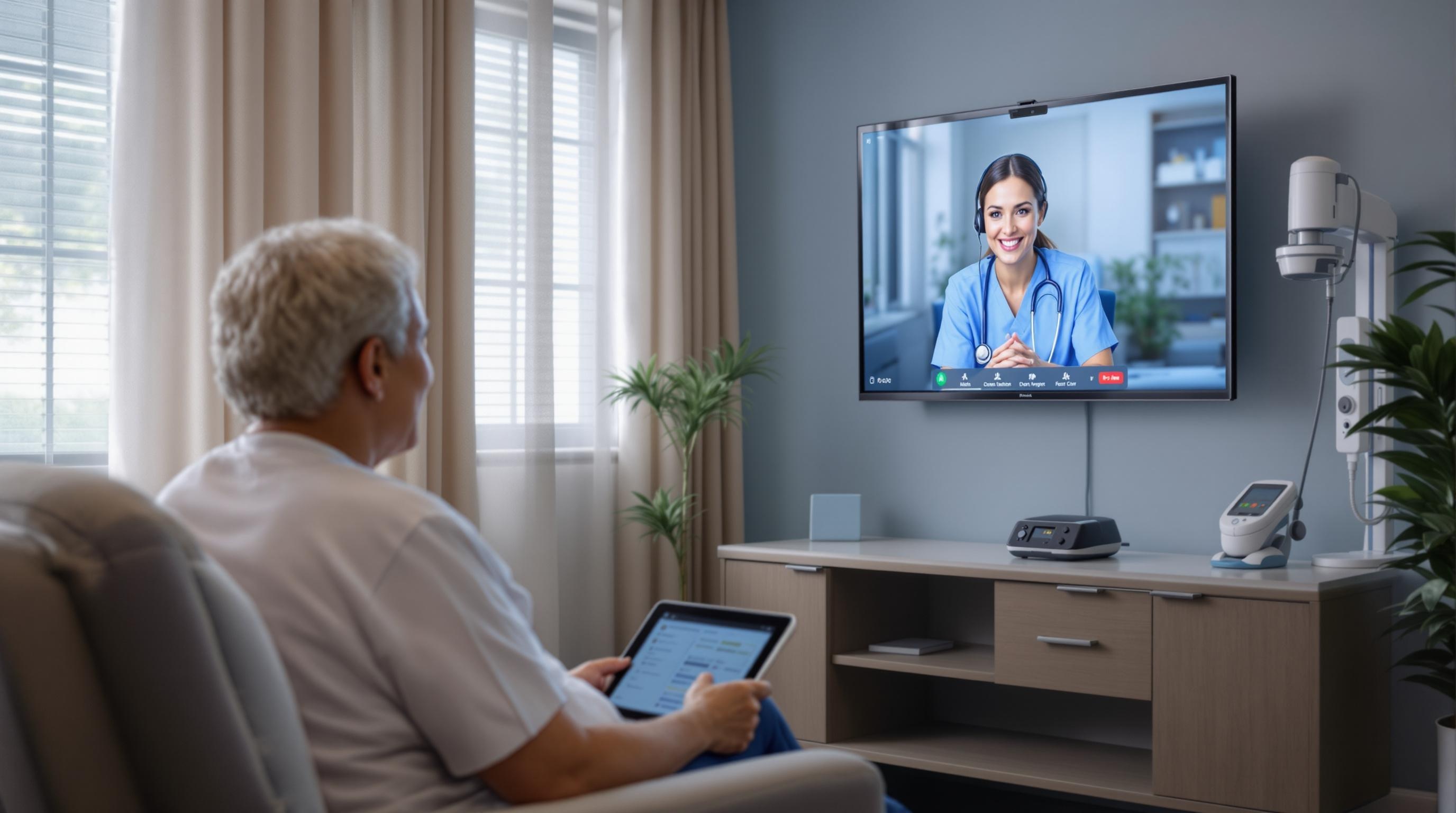Virtual Care RN Services: Transforming Skilled Nursing Facilities
Discover how virtual care RN services enhance patient outcomes, improve staffing, and streamline workflows for skilled nursing facilities.
Quick Navigation
- 1. Introduction
- 2. Current Challenges in Virtual Care RN Services
- 3. How Sparkco AI Transforms Virtual Care RN Services
- 4. Measurable Benefits and ROI
- 5. Implementation Best Practices
- 6. Real-World Examples
- 7. The Future of Virtual Care RN Services
- 8. Conclusion & Call to Action
1. Introduction
Did you know that eight out of ten nursing leaders are actively piloting new care models to meet today’s healthcare challenges? According to a recent Wolters Kluwer survey, the traditional approach to nursing in skilled nursing facilities (SNFs) is rapidly evolving. Chronic staffing shortages, rising patient acuity, and the lingering effects of the COVID-19 pandemic have forced organizations to rethink how they deliver quality care while supporting overburdened nurses [source]. In this shifting landscape, virtual care RN services have emerged as an innovative, practical solution—enabling skilled nursing facilities to extend expert clinical support, streamline workflows, and improve resident outcomes without increasing on-site staff.
The problem is clear: SNFs are grappling with limited nursing resources, mounting regulatory demands, and a growing population of residents with complex medical needs. Traditional staffing models are no longer sustainable, leading to burnout, turnover, and gaps in care. Virtual care RN services—powered by technology and remote clinical expertise—are helping facilities bridge these gaps by providing real-time assessment, triage, education, and care coordination from afar.
In this article, we’ll explore how virtual care RN services are transforming skilled nursing facilities. We’ll discuss the latest trends, examine the benefits and challenges, and highlight real-world applications that are shaping the future of post-acute and long-term care. Whether you’re an administrator, clinician, or caregiver, discover how virtual nursing is redefining what’s possible in skilled nursing facilities—and why it’s quickly becoming an essential part of modern healthcare delivery.
2. Current Challenges in Virtual Care RN Services
The rapid adoption of virtual care RN services has transformed healthcare delivery, particularly in skilled nursing facilities and hospitals. While these services offer flexibility and broader access to nursing care, healthcare organizations are encountering several significant challenges as they integrate virtual registered nurses (RNs) into clinical workflows. Below, we outline key pain points, supported by industry statistics, and explore their impact on operations, compliance, and patient care.
-
1. Technology Infrastructure and Digital Divide
Many facilities lack robust digital infrastructure to support seamless virtual care. According to a 2022 Health Affairs report, 38% of rural healthcare providers cite unreliable internet connectivity as a barrier to virtual care. This hampers video consultations, delays response times, and can result in missed care opportunities. -
2. Integration with Existing Workflows
Virtual RNs often use separate platforms that may not integrate smoothly with electronic health records (EHRs) or bedside systems. The Becker’s Hospital Review notes that 52% of facilities report difficulties in coordinating virtual and in-person care, leading to workflow inefficiencies and fragmented patient documentation. -
3. Regulatory and Compliance Concerns
State licensure requirements and varying telehealth regulations complicate the deployment of virtual RNs across state lines. A Journal of Ethics article highlights that 41% of healthcare leaders are concerned about maintaining compliance with HIPAA and interstate licensure when using virtual care staff. -
4. Data Security and Privacy Risks
The increased use of video and digital communication platforms raises the risk of data breaches. According to the HIPAA Journal, healthcare data breaches affected over 59 million individuals in 2022, with telehealth platforms being a growing target for cyberattacks. -
5. Staff Training and Adaptation
Ensuring that both on-site teams and virtual RNs are proficient in using new technology is a persistent challenge. Research by the National Institutes of Health (NIH) shows that 45% of nurses feel inadequately trained for telehealth roles, impacting their confidence and the quality of care delivered remotely. -
6. Patient Engagement and Satisfaction
Not all patients are comfortable with or have access to virtual care technology. A 2023 Pew Research Center study found that 27% of older adults have difficulty using telehealth platforms, leading to lower satisfaction and engagement. -
7. Reimbursement and Financial Uncertainty
Unclear reimbursement policies for virtual RN services can strain facility finances. The American Hospital Association notes that only 46% of providers report consistent payment from payers for telehealth nursing services, making it challenging to sustain virtual care programs long-term.
These challenges have a direct impact on healthcare operations by slowing adoption, increasing administrative burden, and complicating compliance. Patient care may suffer due to technological barriers, inconsistent workflows, and lower engagement, while facilities risk financial losses without clear reimbursement models. Addressing these pain points is essential to fully realize the benefits of virtual care RN services in modern healthcare.
3. How Sparkco AI Transforms Virtual Care RN Services
Skilled nursing facilities (SNFs) face mounting challenges when providing virtual care Registered Nurse (RN) services, including staffing shortages, complex patient monitoring, timely intervention, documentation burdens, and seamless integration with existing workflows. Sparkco AI delivers innovative solutions designed to overcome these obstacles, empowering virtual RNs and enhancing patient outcomes.
-
Real-Time Patient Monitoring and Alerts
Sparkco AI continuously monitors patient data from multiple sources—vital signs, electronic health records, and wearable devices. Its intelligent system analyzes trends and instantly notifies virtual RNs about potential clinical changes. This proactive approach helps nurses respond rapidly to emerging issues, reducing avoidable hospitalizations and ensuring timely care. -
Automated Documentation Assistance
Sparkco AI streamlines the documentation process by capturing patient interactions and automatically updating health records. This reduces manual entry, minimizes errors, and allows RNs to focus more on patient care rather than paperwork. The automation ensures compliance and accuracy, supporting better audit readiness. -
Smart Triage and Prioritization
The platform uses advanced AI algorithms to assess patient acuity and prioritize cases based on urgency. This helps virtual RNs allocate their attention where it’s needed most, ensuring critical cases are never overlooked and routine monitoring is handled efficiently. -
Intuitive Communication Tools
Sparkco AI offers secure messaging, video conferencing, and instant alerts within a unified interface. With these user-friendly tools, virtual RNs can quickly connect with on-site staff, physicians, and family members, streamlining care coordination and decision-making. -
Guided Clinical Decision Support
By leveraging up-to-date clinical guidelines and patient-specific insights, Sparkco AI provides actionable recommendations to RNs during virtual consultations. This support reduces uncertainty, standardizes care protocols, and helps less-experienced nurses deliver high-quality care. -
Seamless EHR and Workflow Integration
Sparkco AI is designed for compatibility with leading electronic health record (EHR) systems and existing facility workflows. Its open integration capabilities mean that facilities can deploy Sparkco AI without disrupting established processes, allowing for a smooth transition and immediate value.
By combining advanced AI with robust automation, Sparkco AI solves the toughest virtual care RN challenges. Facilities benefit from improved patient monitoring, reduced administrative workload, better communication, and enhanced clinical outcomes—all while ensuring that technology fits naturally into daily operations. Sparkco AI empowers SNFs to deliver safer, more efficient, and more responsive virtual RN services.
4. Measurable Benefits and ROI
Automated Virtual Care RN Services are transforming skilled nursing facilities by streamlining workflows, improving patient outcomes, and optimizing operational costs. As healthcare systems face ongoing staffing shortages and increasing regulatory demands, the adoption of virtual nursing presents a compelling return on investment (ROI) with quantifiable benefits. Below, we explore the key data-driven advantages supported by industry research and real-world case studies.
-
1. Time Savings and Workflow Efficiency
Virtual RNs can reduce bedside nurse workload by up to 20%, freeing clinical staff to focus on direct patient care. For example, automating admission assessments and discharge planning can save 15-30 minutes per patient episode (HealthLeaders). -
2. Cost Reduction Through Staffing Optimization
Facilities implementing virtual care have reported a 10-15% reduction in overall labor costs by maximizing RN coverage and reducing overtime. Virtual nurses can cover multiple units or facilities simultaneously, alleviating the need for costly agency staff. -
3. Improved Nurse Retention and Satisfaction
Turnover rates for bedside nurses can drop by up to 30% with virtual RN support, as workloads become more manageable and burnout decreases (HealthLeaders Mastermind). -
4. Enhanced Patient Safety and Quality
Virtual RNs contribute to a 25% decrease in medication errors and improved compliance with safety protocols by providing real-time double checks during high-risk processes. -
5. Increased Regulatory Compliance
Automated chart audits and documentation reviews by virtual RNs improve compliance with CMS and Joint Commission standards, leading to a reported 40% reduction in survey deficiencies in some programs. -
6. Faster Response Times and Patient Throughput
Virtual nurse triage can reduce average patient wait times by up to 50%, expediting admissions, discharges, and care transitions across the facility. -
7. Consistent Education and Patient Engagement
Facilities leveraging virtual RN education have documented a 35% increase in patient understanding of care plans, resulting in higher HCAHPS scores and reduced readmissions. -
8. Scalable Support for After-Hours and On-Demand Care
Virtual RNs provide 24/7 coverage, reducing after-hours call burden on onsite staff and ensuring immediate response for patient needs—even during off-peak times.
Multiple health systems have validated these outcomes through pilot programs and published results. For example, HealthLeaders’ Virtual Nursing Mastermind highlighted these metrics as key drivers for sustainability and ROI in virtual nursing initiatives.
In summary, automated virtual care RN services deliver measurable ROI through time and cost savings, improved compliance, and enhanced quality of care. These benefits support both financial sustainability and better patient outcomes, positioning virtual nursing as a strategic imperative for skilled nursing facilities.
5. Implementation Best Practices
Successfully implementing virtual care RN services in skilled nursing facilities requires a strategic, step-by-step approach. The following best practices provide a roadmap to ensure a smooth transition, maximize clinical outcomes, and maintain regulatory compliance.
-
Conduct a Readiness Assessment
Evaluate your facility’s current technology infrastructure, staffing, and workflow capabilities. Identify gaps in internet connectivity, device availability, and staff digital literacy.
Tip: Use a standardized checklist and involve IT, clinical, and administrative staff in the assessment.
Pitfall to Avoid: Underestimating training needs or technology limitations can delay implementation. -
Engage Stakeholders Early
Secure buy-in from leadership, clinical teams, residents, and families. Clearly communicate the benefits of virtual care RN services, such as improved access to care and timely interventions.
Tip: Host informational sessions and Q&A forums to address concerns.
Pitfall to Avoid: Overlooking the importance of change management and communication. -
Develop Clear Policies and Procedures
Draft detailed protocols for virtual RN workflows, documentation, privacy, and communication. Align these with CMS regulations and state-specific telehealth guidelines.
Tip: Regularly review and update policies as regulations evolve.
Pitfall to Avoid: Failing to align protocols with compliance requirements. -
Select and Integrate Technology Solutions
Choose HIPAA-compliant telehealth platforms that integrate seamlessly with your EHR. Test connectivity, audio/visual quality, and interoperability before launch.
Tip: Pilot the solution with a small group before full-scale deployment.
Pitfall to Avoid: Skipping thorough testing can lead to workflow disruptions. -
Provide Comprehensive Training
Offer hands-on training for RNs, support staff, and residents. Focus on platform navigation, troubleshooting, and best practices for virtual patient engagement.
Tip: Supplement live training with on-demand resources and ongoing support.
Pitfall to Avoid: One-time training without follow-up leads to skill gaps. -
Monitor Performance and Collect Feedback
Establish metrics to track utilization, clinical outcomes, and satisfaction. Solicit feedback from staff and residents to identify improvement opportunities.
Tip: Schedule regular debriefs and share performance dashboards.
Pitfall to Avoid: Ignoring user feedback can stall adoption and quality improvement. -
Iterate and Scale
Refine processes based on data and feedback. Gradually expand virtual care RN services to additional units or facilities as confidence grows.
Tip: Celebrate early successes to build momentum.
Pitfall to Avoid: Expanding too quickly without addressing early-stage challenges. -
Maintain Regulatory Compliance
Stay up-to-date on CMS and state telehealth policies, including documentation standards and billing requirements.
Tip: Designate a compliance champion to monitor regulatory changes.
Pitfall to Avoid: Overlooking documentation or billing updates can threaten reimbursement.
Change management is central to success—prioritize transparent communication, provide ongoing education, and foster a culture of adaptability. By following these steps, skilled nursing facilities can harness the full potential of virtual care RN services and deliver high-quality, patient-centered care.










